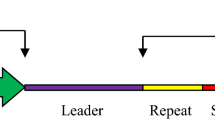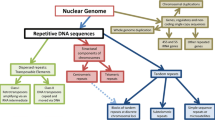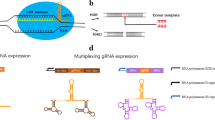Abstract
Tandem repeats belong to a class of genomic repetitive elements that form arrays of head-to-tail monomers. Due to technical difficulties in sequencing and assembly of large tandem repeat arrays, it remains largely unknown by which mechanisms tandem-repeat-containing regions aid in maintenance of ordered radial genome organization during interphase. Here we analyzed spatial distribution of several types of tandem repeats in interphase nuclei of chicken MDCC-MSB1 cells and somatic tissues relative to heterochromatin compartments and nuclear center. We showed that telomere and subtelomere repeats generally localize at the nuclear or chromocenters periphery. A tandem repeat known as CNM, typical for centromere regions of gene-dense microchromosomes, forms interchromosome clusters and occupies DAPI-positive chromocenters that appear predominantly within the nuclear interior. In contrast, centromere-specific tandem repeats of the majority of gene-poor macrochromosomes are embedded into the peripheral layer of heterochromatin. Chicken chromocenters rarely comprise centromere sequences of both macro- and microchromosomes, whose territories localize in different radial nuclear zones. Possible mechanisms of observed tandem repeats positioning and its implication in highly ordered arrangement of chromosome territories in chicken interphase nucleus are discussed.








Similar content being viewed by others
Abbreviations
- 3C:
-
Chromosome conformation capture
- 3D:
-
Three-dimensional
- BAC:
-
Bacterial artificial chromosome
- Cen:
-
Centromere-specific sequence
- CENP:
-
Centromere protein
- CEF:
-
Chicken embryonic fibroblasts
- CNM:
-
Chicken nuclear-membrane-associated repeat
- CR1:
-
Chicken repetitive 1 element
- DAPI:
-
4′,6-Diamidino-2-phenylindole
- FISH:
-
Fluorescent in situ hybridization
- GGA:
-
Chicken (Gallus gallus) chromosome
- LAD:
-
Lamina-associated domain
- MDCC:
-
Marek’s disease chicken cell line
- PO41:
-
Pattern of 41 bp repeat
References
Akiyama Y, Kato S (1974) Two cell lines from lymphomas of Marek's disease. Biken J 17:105–116
Alcobia I, Dilão R, Parreira L (2000) Spatial associations of centromeres in the nuclei of hematopoietic cells: evidence for cell–type–specific organizational patterns. Blood 95:1608–1615
Beil M, Dürschmied D, Paschke S et al (2002) Spatial distribution patterns of interphase centromeres during retinoic acid–induced differentiation of promyelocytic leukemia cells. Cytometry 47:217–225
Berchtold D, Fesser S, Bachmann G et al (2011) Nuclei of chicken neurons in tissues and three–dimensional cell cultures are organized into distinct radial zones. Chromosome Res 19:165–182
Bickmore WA (2013) The spatial organization of the human genome. Annu Rev Genomics Hum Genet 14:67–84
Boyle S, Gilchrist S, Bridger JM, Mahy NL, Ellis JA, Bickmore WA (2001) The spatial organization of human chromosomes within the nuclei of normal and emerin–mutant cells. Hum Mol Genet 10:211–219
Brero A, Easwaran HP, Nowak D et al (2005) Methyl CpG–binding proteins induce large–scale chromatin reorganization during terminal differentiation. J Cell Biol 169:733–743
Carvalho C, Pereira HM, Ferreira J et al (2001) Chromosomal G–dark bands determine the spatial organization of centromeric heterochromatin in the nucleus. Mol Biol Cell 12:3563–3572
Cavalli G, Misteli T (2013) Functional implications of genome topology. Nat Struct Mol Biol 20:290–299
Comings DE (1980) Arrangement of chromatin in the nucleus. Hum Genet 53:131–143
Cremer M, von Hase J, Volm T et al (2001) Non–random radial higher–order chromatin arrangements in nuclei of diploid human cells. Chromosome Res 9:541–567
Croft JA, Bridger JM, Boyle S, Perry P, Teague P, Bickmore WA (1999) Differences in the localization and morphology of chromosomes in the human nucleus. J Cell Biol 145:1119–1131
Deryusheva S, Krasikova A, Kulikova T, Gaginskaya E (2007) Tandem 41–bp repeats in chicken and Japanese quail genomes: FISH mapping and transcription analysis on lampbrush chromosomes. Chromosoma 116:519–530
Fedorova E, Zink D (2008) Nuclear architecture and gene regulation. Biochim Biophys Acta 1783:2174–2184
Fukagawa T, Pendon C, Morris J, Brown W (1999) CENP–C is necessary but not sufficient to induce formation of a functional centromere. EMBO J 18:4196–4209
Gibcus JH, Dekker J (2013) The hierarchy of the 3D genome. Mol Cell 49:773–782
Guenatri M, Bailly D, Maison C, Almouzni G (2004) Mouse centric and pericentric satellite repeats form distinct functional heterochromatin. J Cell Biol 166:493–505
Guttenbach M, Nanda I, Feichtinger W, Masabanda JS, Griffin DK, Schmid M (2003) Comparative chromosome painting of chicken autosomal paints 1–9 in nine different bird species. Cytogenet Genome Res 103:173–184
Haaf T, Schmid M (1991) Chromosome topology in mammalian interphase nuclei. Exp Cell Res 192:325–332
Habermann FA, Cremer M, Walter J et al (2001) Arrangements of macro– and microchromosomes in chicken cells. Chromosome Res 9:569–584
Harnicarová Horáková A, Galiová G, Legartová S, Kozubek S, Matula P, Bártová E (2010) Chromocentre integrity and epigenetic marks. J Struct Biol 169:124–133
Hori T, Suzuki Y, Solovei I et al (1996) Characterization of DNA sequences constituting the terminal heterochromatin of the chicken Z chromosome. Chromosome Res 4:411–426
Hsu TC, Cooper JE, Mace ML Jr, Brinkley BR (1971) Arrangement of centromeres in mouse cells. Chromosoma 34:73–87
Hughes AL, Piontkivska H (2005) DNA repeat arrays in chicken and human genomes and the adaptive evolution of avian genome size. BMC Evol Biol 5:12
Iannuccelli E, Mompart F, Gellin J, Lahbib-Mansais Y, Yerle M, Boudier T (2010) NEMO: a tool for analyzing gene and chromosome territory distributions from 3D–FISH experiments. Bioinformatics 26:696–697
International Chicken Genome Sequencing Consortium (2004) Sequence and comparative analysis of the chicken genome provide unique perspectives on vertebrate evolution. Nature 432:695–716
Ishishita S, Tsuruta Y, Uno Y et al (2014) Chromosome size–correlated and chromosome size–uncorrelated homogenization of centromeric repetitive sequences in New World quails. Chromosome Res 22:15–34
Itoh Y, Mizuno S (2002) Molecular and cytological characterization of SspI–family repetitive sequence on the chicken W chromosome. Chromosome Res 10:499–511
Jin QW, Fuchs J, Loidl J (2000) Centromere clustering is a major determinant of yeast interphase nuclear organization. J Cell Sci 113:1903–1912
Jost KL, Bertulat B, Cardoso MC (2012) Heterochromatin and gene positioning: inside, outside, any side? Chromosoma 121:555–563
Kodama H, Saitoh H, Tone M, Kuhara S, Sakaki Y, Mizuno S (1987) Nucleotide sequences and unusual electrophoretic behavior of the W chromosome–specific repeating DNA units of the domestic fowl, Gallus gallus domesticus. Chromosoma 96:18–25
Krasikova A, Deryusheva S, Galkina S, Kurganova A, Evteev A, Gaginskaya E (2006) On the positions of centromeres in chicken lampbrush chromosomes. Chromosome Res 14:777–789
Krasikova A, Fukagawa T, Zlotina A (2012) High–resolution mapping and transcriptional activity analysis of chicken centromere sequences on giant lampbrush chromosomes. Chromosome Res 20:995–1008
Krijger PH, de Laat W (2013) Identical cells with different 3D genomes; cause and consequences? Curr Opin Genet Dev 23:191–196
Li J, Leung FC (2006) A CR1 element is embedded in a novel tandem repeat (HinfI repeat) within the chicken genome. Genome 49:97–103
Lieberman-Aiden E, van Berkum NL et al (2009) Comprehensive mapping of long–range interactions reveals folding principles of the human genome. Science 326:289–293
Manuelidis L (1990) A view of interphase chromosomes. Science 250:1533–1540
Manvelyan M, Hunstig F, Bhatt S et al (2008) Chromosome distribution in human sperm—a 3D multicolor banding–study. Mol Cytogenet 1:25
Matzke MA, Varga F, Berger H et al (1990) A 41–42 bp tandemly repeated sequence isolated from nuclear envelopes of chicken erythrocytes is located predominantly on microchromosomes. Chromosoma 99:131–137
Meyne J, Ratliff RL, Moyzis RK (1989) Conservation of the human telomere sequence (TTAGGG)n among vertebrates. Proc Natl Acad Sci U S A 86:7049–7053
Padeken J, Mendiburo MJ, Chlamydas S, Schwarz HJ, Kremmer E, Heun P (2013) The nucleoplasmin homolog NLP mediates centromere clustering and anchoring to the nucleolus. Mol Cell 50:236–249
Plohl M, Meštrović N, Mravinac B (2012) Satellite DNA evolution. Genome Dyn 7:126–152
Politz JC, Scalzo D, Groudine M (2013) Something silent this way forms: the functional organization of the repressive nuclear compartment. Annu Rev Cell Dev Biol 29:241–270
Pombo A, Dillon N (2015) Three-dimensional genome architecture: players and mechanisms. Nat Rev Mol Cell Biol 16:245–257
Rajapakse I, Groudine M (2011) On emerging nuclear order. J Cell Biol 192:711–721
Sage BT, Csink AK (2003) Heterochromatic self–association, a determinant of nuclear organization, does not require sequence homology in Drosophila. Genetics 165:1183–1193
Saitoh Y, Mizuno S (1992) Distribution of XhoI and EcoRI family repetitive DNA sequences into separate domains in the chicken W chromosome. Chromosoma 101:474–477
Saitoh Y, Saitoh H, Ohtomo K, Mizuno S (1991) Occupancy of the majority of DNA in the chicken W chromosome by bent–repetitive sequences. Chromosoma 101:32–40
Schindelin J, Arganda-Carreras I, Frise E et al (2012) Fiji: an open–source platform for biological–image analysis. Nat Methods 9:676–682
Schmid M, Nanda I, Hoehn H et al (2005) Second report on chicken genes and chromosomes 2005. Cytogenet Genome Res 109:415–479
Shang WH, Hori T, Toyoda A et al (2010) Chickens possess centromeres with both extended tandem repeats and short non–tandem–repetitive sequences. Genome Res 20:1219–1228
Shopland LS, Lynch CR, Peterson KA et al (2006) Folding and organization of a contiguous chromosome region according to the gene distribution pattern in primary genomic sequence. J Cell Biol 174:27–38
Skinner BM, Völker M, Ellis M, Griffin DK (2009) An appraisal of nuclear organisation in interphase embryonic fibroblasts of chicken, turkey and duck. Cytogenet Genome Res 126:156–164
Solovei I, Gaginskaya ER, Macgregor HC (1994) The arrangement and transcription of telomere DNA sequences at the ends of lampbrush chromosomes of birds. Chromosome Res 2:460–470
Tanay A, Cavalli G (2013) Chromosomal domains: epigenetic contexts and functional implications of genomic compartmentalization. Curr Opin Genet Dev 23:197–203
Tone M, Nakano N, Takao E, Narisawa S, Mizuno S (1982) Demonstration of W chromosome–specific repetitive DNA sequences in the domestic fowl Gallus g domesticus. Chromosoma 86:551–569
Towbin BD, Gonzalez-Sandoval a, Gasser SM (2013) Mechanisms of heterochromatin subnuclear localization. Trends Biochem Sci 38:356–363
Trofimova I, Popova D, Vasilevskaya E, Krasikova A (2014) Non–coding RNA derived from a conservative subtelomeric tandem repeat in chicken and Japanese quail somatic cells. Mol Cytogenet 7:102
Wang X, Li J, Leung FC (2002) Partially inverted tandem repeat isolated from pericentric region of chicken chromosome 8. Chromosome Res 10:73–82
Wicker T, Robertson JS, Schulze SR et al (2005) The repetitive landscape of the chicken genome. Genome Res 15:126–136
Yang F, Trifonov V, Ling Ng B, Kosyakova N, Carter NP (2009) Generation of paint probes by flow–sorted and microdissected chromosomes. In: Liehr T (eds) Fluorescence in situ hybridization (FISH)—application guide. Springer-Verlag Springer, Berlin Heidelberg, pp 35–52
Zlotina A, Galkina S, Krasikova A et al (2012) Centromere positions in chicken and Japanese quail chromosomes: de novo centromere formation versus pericentric inversions. Chromosome Res 20:1017–1032
Zullo JM, Demarco IA, Piqué-Regi R et al (2012) DNA sequence–dependent compartmentalization and silencing of chromatin at the nuclear lamina. Cell 149:1474–1487
Acknowledgments
The research of NK (performed GGA4 arms microdissection) was supported by the Jena/St Petersburg University Partnership Program funded by DAAD. The research of AM, AZ, MS, and AK (performed all other experiments and drafted the manuscript) was supported by Russian Science Foundation (grant #14-14-00131). The work was partially performed using experimental equipment of the Research Resource Centers “Chromas” and “Molecular and Cell Technologies” of St Petersburg State University.
Author information
Authors and Affiliations
Corresponding author
Additional information
Responsible Editors: Maria Assunta Biscotti, Pat Heslop-Harrison and Ettore Olmo
Electronic supplementary material
Below is the link to the electronic supplementary material.
Fig. S1
Chromocenters in chicken interphase nuclei. a, b, c Single confocal sections of three representative DAPI-stained MDCC-MSB1 lymphoblast nuclei. Arrows point on chromocenters located within nuclear interior (2 on the panel a’) and at the inner border of peripheral heterochromatin (1 and 3 on the panel a’) or within peripheral heterochromatin near the nuclear envelope (1 and 2 on the panel b’). Blocks of perinucleolar heterochromatin (arrowheads) surround nucleoli (c’). a”, b”, c” Prominent peaks in fluorescence intensity profiles through the line regions of interest (ROI). Scale bars 5 μm (PDF 517 kb)
Fig. S2
Patterns of active and inactive chromatin marks in chicken MDCC-MSB1 lymphoblasts. Single confocal sections of nuclei after immunofluorescent staining with specific antibodies against dimethylated H3K9 (а’), trimethylated H3K9 (b’), trimethylated H3K27 (c’), trimethylated H3K4 (d’), hyperacetylated H4 (e’), and Sm proteins of snRNPs (f’). Nuclei are counterstained with DAPI (a–g). Arrows indicate chromocenters, arrowheads point to nucleoli. Scale bars 5 μm (PDF 724 kb)
Fig. S3
CNM clusters in chicken somatic cells. Single confocal sections of chicken MDCC-MSB1 lymphoblast (а–а”), chicken embryonic fibroblasts (b–b”), erythrocytes (c–c”), ovarian somatic cells (d–d”), smooth muscle cells (e–e”), lamina propria cells (f–f”), and enterocytes (g–g”) of small intestine villi after FISH detection of CNM repeats (a’–g’). Nuclei are counterstained with DAPI (a–g). In all cell types, CNM-rich foci (arrowheads) co-localize with DAPI-positive chromocenters (arrows) (a”–g”). Boxplots below show the number of CNM foci in different cell types (h). Boxes represent median and quartiles, while whiskers show maximal and minimal values. Scale bars 10 μm (PDF 1380 kb)
Fig. S4
Localization of W-specific tandem repeats within the chromocenter that is largely devoid of CNM repeats. a’, b’ Single confocal sections of nuclei after dual-color FISH detection of EcoRI, SspI, and XhoI repeats. a, b Nuclei counterstained with DAPI. a”, b” 3D surface reconstructions of corresponding nuclei with segmented chromocenters and EcoRI-, SspI-, and XhoI-repeat foci. Scale bars 5 μm (PDF 277 kb)
Fig. S5
Localization of CNM foci relative to nucleoli in chicken MDCC-MSB1 lymphoblasts. a’–d’ Single confocal sections of nuclei after immunofluorescent staining with antibody against fibrillarin and FISH detection of CNM repeats. a–d Nuclei counterstained with DAPI. Arrowheads point on CNM foci associated with nucleoli. Arrows mark CNM arrays which do not localize to nucleolus. Scale bars 5 μm (PDF 469 kb)
Fig. S6
Distribution of centromere regions of chicken macrochromosomes and microchromosome 27 relative to peripheral heterochromatin in chicken interphase nucleus. a, b, c, d Schematic drawings of centromere position (green circle) variants relative to peripheral heterochromatin (blue), chromocenters (dark blue), and inner nuclear region (light blue). a’, b’, c’, d’ Representative single confocal images of MDCC-MSB1 and CEF cell nuclei after FISH detection of Cen. Nuclei are counterstained with DAPI. a”, b”, c”, d” Bar graphs, demonstrating relative frequencies of Cen1–4, 7, 8, 11, Z and 27 locations in depicted nuclear regions of MDCC-MSB1 cells. Scale bars 5 μm (PDF 739 kb)
Rights and permissions
About this article
Cite this article
Maslova, A., Zlotina, A., Kosyakova, N. et al. Three-dimensional architecture of tandem repeats in chicken interphase nucleus. Chromosome Res 23, 625–639 (2015). https://doi.org/10.1007/s10577-015-9485-5
Published:
Issue Date:
DOI: https://doi.org/10.1007/s10577-015-9485-5




